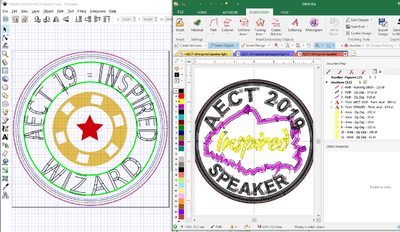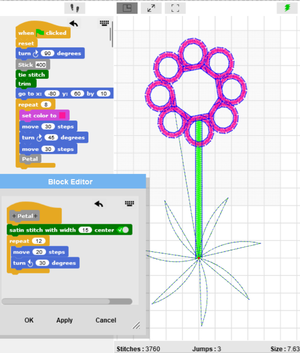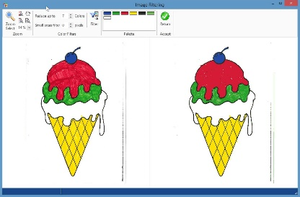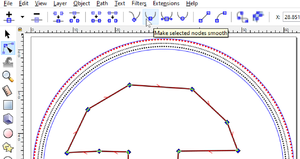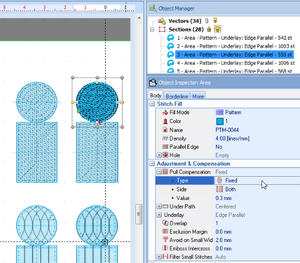Digital embroidery to teach ICT skills (AECT 2019)
Handout for poster presented at AECT 2019, October 2019, Las Vegas, USA (wiki version).
- Daniel Schneider, Kalliopi Benetos & Lydie Boufflers,
- TECFA, Faculté de Psychologie et des Sciences de l’Education
- Université de Genève, Switzerland
daniel.schneider@unige.ch, kalliopi.benetos@unige.ch, lydie.boufflers@unige.ch
Introduction
Digital embroidery can be used as a motivating medium to teach various ICT skills, in addition to design and soft skills. The literature discusses four reasons for the educational use of computer-aided design and manufacturing (CAD/CAM), called “digital design and fabrication”, “design and technology” or “making” in a non-industrial context: (1) It allows the teaching of programming (Brady, 2017), vector drawing, mathematics, environmental and societal issues. (2) “Making” teaches planning and cooperation, and develops metacognitive skills (Blikstein, 2013). (3) It promotes design skills essential for the future economy (Barlex, 2011). (4) Teachers can create or adapt constructive learning objects (Zuckerman, 2010). We shall develop the use of digital embroidery to teach ICT skills.
School children do not “naturally” acquire digital literacy. In particular, the younger generation seems to have little mastery of professional software and little involvement in the creation of technical artifacts (Kirschner & de Bruyckere, 2017; Baron & Bruillard, 2008). Gershenfeld’s (2005) course “how to make almost anything”, characterized by project-based pedagogy, just-in-time organization and strong collaboration among students has served as a model for creating emancipatory and pedagogical fab labs. At the same time, Do It Yourself (DIY) and crafts have been revived through digital design and online sharing. Initiatives to develop digital literacy were launched in many countries and should consider introducing digital design and fabrication, since it can play an integrating role between technology, informatics, design, art and standard subjects, and help to overcome some of the difficulties in adopting ICT (Barlex, 2011).
According to Blikstein (2013), educators who introduce “making” in their classes refer to Papert's constructionism, as well as to the libertarian pedagogies of Freire or Freinet. Making embodies human nature as a “hand in action” shaping the environment and raises challenges that require creativity and technical skills. Combined with design thinking, it could develop 21st century skills such as digital competence, problem-solving strategies and self-regulation.
The case for digital embroidery
Most initiatives that introduce making in general education focus on 3D printing. We postulate that digital embroidery deserves a more prominent place: it is a reliable, low-risk technology that does not convey stereotypes associated with engineering. Embroidery allows creating objects that have a positive and transformative connotation (Gell, 1998). In school makerspaces we find 3D printing, laser cutting, vinyl cutting and electronics. Embroidery is absent, despite the artistic flavor of textiles (Kafai et al., 2010), which favors creative thinking more than robotics preferred by many ICT teachers. It allows developing vector drawing (the basis of multimedia and digital design), image processing, and using complex software. It develops soft skills such as design, understanding material constraints, collaboration, and "craftivism".
Computerized embroidery is an interesting entry point to CAD/CAM and computer science. Compared to laser cutting, embroidery is less expensive. Compared to 3D printing, embroidery is much faster. Compared to both, embroidery presents fewer potential health risks and is more environmentally friendly. It could be of interest to creative children who are not attracted to engineering and could be taught in synergy with drawing classes.
Since 2011, we are offering a master level course on making (3D printing, laser cutting and machine embroidery) in education. This course includes a technical introduction, participation in the writing of a virtual book, a project to be carried out with external participants and participation in an "outreach" event. Projects include communication, games, pedagogical scripting, special education and identity work, of which we will show examples. Students in educational technology learn technology relatively easily and acquire transferable skills, e.g. creating embroidery improved vector drawing and image manipulation skills.
In order to test the public interest in digital embroidery and its use in education, we organized several outreach events since 2018 (N=a few hundred). Participants create a hand drawing that our students transform into embroidery by showing them the entire process. A questionnaire administered to 78 participants (M_age=18.10, SD_age=14.18, 47% F) at one of these events measured their interest and perceived difficulty. The questionnaire was divided into two parts. Before the activity, participants were asked to estimate the difficulty of 3 tasks (drawing, vectorization, embroidery) on a 7-point scale. After each task, they engaged in the same evaluation. The participants have a stable image of the difficulty of drawing and vectorization but reevaluate downwards the difficulty of creating an embroidery with a machine. Interest in the activity was very high (on a scale of 1 to 7, M=6.91, SD=0.29). The motivation to learn more in the future was somewhat lower (M=5.69, SD=1.55). These results show that embroidery can foster a certain commitment and that its difficulty is perceived as “affordable”, two interesting conditions to continue to develop this avenue.
A simplified workflow diagram as well as a list of ICT skills that can be taught and learned through digital embroidery are presented, below, in the PDF and the poster .
Embroidery workflows
Designing a machine stitchable embroidery can follow a diverse workflow, as shown in the figure below. People can start from hand drawings or raster images (requiring image manipulation and vectorization). Most digital designers probably start from a vector drawing, sometimes reusing clipart. Others may directly draw embroidery objects. Using digitized fonts is recommended for creating text. Once drawings are translated into parameterizable embroidery objects, a lot of fine tuning can be done. Digital embroidery to teach ICT skills
Digital embroidery to teach ICT skills
A list of ICT skills that can be taught and learned through digital embroidery
A number of specific ICT skills can be taught and learnt through digital embroidery, among which are vector drawing, programming, image manipulation, vector manipulation, physical constraints of maker technology, parametrization in complex software, and some system administration.
| Vector drawing
Vector drawing is a useful ICT skill. E.g. illustrations in Word, Power Point, or learning materials benefit from custom drawings. Being able to create shapes for computer animations and other making technologies is essential. | |
| Programming
Embroidery can be programmed, e.g. with the free online turtlestitch program (http://turtlestitch.org) Quote: based on a browser-based educational programming language (Snap!) to generate patterns for embroidery machines. It is easy to use, requiring no prior knowledge in programming, yet powerful in creating novel patterns for embroidery. | |
| Image manipulation
Raster images have to be simplified to be vectorized. E.g,. color reduction, change contrast, remove specks are useful skills for other contexts. Vectorizing/tracing skills are useful in many domains. First of all, learners will have to revise their knowledge on file formats. | |
| Vector manipulation
Imported or created vector “paths” must be reshaped, broken, glued, etc. This encourages learning advanced functionally of a vector drawing program or a vector drawing module. | |
| Physical constraints
Each fabrication method must consider various physical constraints. Students will learn that a model seen on the screen may not «print» as expected and that model design has to take into account materials parameters. | |
| Parametrization
Advanced commercial software such as Stitch Era includes hundreds of parameters that can be set, in particular for embroidery objects. This allow training learners to look at objects that can be parametrized in many ways and to explore menus. | |
| System administration
Installing open source software such InkStitch requires understanding the file system, permissions, managing zip files, etc. and following instructions to the letter. |
References
Baron, G. & Bruillard, E. (2008). Technologies de l’information et de la communication et indigènes numériques : quelle situation ? STICEF, 15, 1–12.
Barlex, D. (2011). Dear minister, this is why design and technology is a very important subject in the school curriculum. Design and Technology Education, 16 (3), 9-18.
Blikstein, P. (2013). Digital Fabrication and Making in Education: The Democratization of Invention. In J. Walter-Herrmann & C. Büching (Eds.), FabLabs: Of Machines, Makers and Inventors, Bielefeld: Transcript.
Brady,C. K. Orton, D. Weintrop, G. Anton, S. Rodriguez & Wilensky, U (2017). All Roads Lead to Computing: Making, Participatory Simulations, and Social Computing as Pathways to Computer Science, IEEE Transactions on Education, 60 (1), 59-66.
Gell, A. (1998), Art and Agency. An Anthropological Theory, Oxford: Clarendon Press.
Gershenfeld, N. (2005). FAB: The Coming Revolution on Your Desktop. From Personal Computers to Personal Fabrication, New York: Basic Books.
Kafai, Y. B; Peppler, K.A., Burke, Q, Moore M. & Glosson D. (2010). Fröbel's forgotten gift: textile construction kits as pathways into play, design and computation. Proceedings of IDC '10.
Kirschner, P. & De Bruyckere, P. (2017). The myths of the digital native and the multitasker. Teaching and Teacher Education 67, 135-142.
Zuckerman, O. (2010). Designing digital objects for learning: lessons from Froebel and Montessori, International Journal of Arts and Technology 3 (1) 124-135.
Links
Poster and handout for download
Directory with materials: http://tecfa.unige.ch/tecfa/talks/schneide/aect19/ (poster, handout and designs)
- Poster (A0 format)
- PDF Handout
Learn more about digital embroidery
EduTechwiki contains a large technical documentation on embroidery principles and embroidery software. It also includes documentation for student projects and outreach events.
